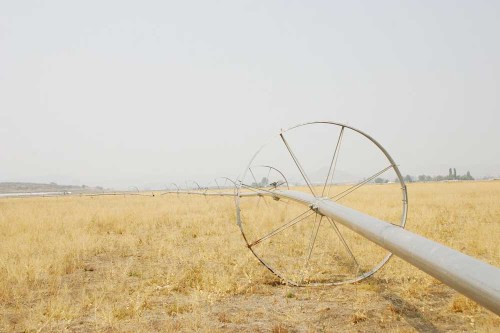Emergency drought permits unlikely for Klamath Basin farmers
Published 1:30 pm Tuesday, February 21, 2023

- Irrigation equipment sits idle in a dried-up hay field near Klamath Falls, Ore.
KLAMATH FALLS, Ore. — The Oregon Water Resources Department is unlikely to issue emergency drought permits for Klamath Basin irrigators in 2023 due to declining groundwater levels that have caused hundreds of domestic wells to run dry.
Emergency permits are one tool the agency may use to mitigate drought impacts for farmers and ranchers, allowing them to temporarily replace water not available under an existing water right from another source.
Trending
The most common drought permit allows water users to pump groundwater as an alternative to surface water when streams and rivers are running low.
Ivan Gall, deputy interim director for water management at OWRD, said the groundwater aquifer around the federal Klamath Project — serving 200,000 acres of farmland in Southern Oregon and Northern California — has been over-appropriated.
Groundwater levels in the area have declined by 20-30 feet over the last three years and by as much as 40 feet since 2001, Gall said.
As a result, the agency received more than 400 complaints in 2021 and 2022 from residents with dry wells.
“We don’t want to exacerbate the situation,” Gall said.
The U.S. Bureau of Reclamation operates the Klamath Project while simultaneously balancing water needs for two species of endangered sucker fish in Upper Klamath Lake, and ESA-listed salmon in the Klamath River below Iron Gate Dam.
Trending
Three consecutive years of intense drought, however, have forced some painful management decisions to meet all requirements. Irrigators received a small portion of their water allotment in 2020 and 2022. Water was shut off entirely to the Project in 2021.
The shortages have prompted many farms to turn to groundwater, Gall said. But the basin already has about 55,000 acres of primary and secondary groundwater rights, which exceed the aquifer’s capacity on an annual basis.
As groundwater levels have declined, Gall said regulators have slowly minimized approving emergency drought permits. Permits that once allowed pumping 2.5 to 3 acre-feet of water per acre were reduced to just 1 acre-foot per acre.
OWRD stopped issuing permits “several years ago” in areas where groundwater levels dropped more than 30 feet, Gall said.
Those restrictions were loosened in 2021, the year surface water was cut off to the Project. Gall said the agency approved 40-50 drought permits at 2.5 acre-feet per acre to provide some relief for irrigators — though it came at a cost for domestic wells.
Last year, OWRD approved just a single drought permit despite water users receiving less than a quarter of their full allotment for the irrigation season.
Gall said the likelihood of even one being issued this year is “very low.”
Paul Simmons, executive director of the Klamath Water Users Association, said he is disappointed by the state’s approach.
The KWUA shares concerns about groundwater levels, Simmons said, and will attempt to work with OWRD on a case-by-case basis to identify any places where pumping may be OK.
“It is disappointing that the state of Oregon stands back, indifferent to federal regulators shutting down surface water deliveries to irrigation water users in Oregon, and only responds by its own regulatory action of shutting down wells that could help mitigate the damage,” Simmons said.
The root of the groundwater crisis, Simmons said, goes back to the federal government’s “excessive regulation” of the Klamath Project, robbing canals and ditches of water that are designed in part to recharge shallow domestic wells for households within its boundaries.
Gall said irrigators with existing groundwater rights will not be affected. The agency may also still approve temporary water transfers, allowing water rights to be moved onto other lands where they may be used to greater benefit.









